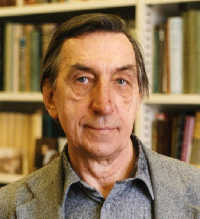Jack Dainty Scholarship
The Jack Dainty Scholarship in Organismal Biology, Ecology and Evolution was established by the family, friends, and colleagues of Professor Jack Dainty. It is awarded to graduate students, who have decided to focus their studies on those areas which were closest to Professor Jack Dainty’s interests in organismal biology, ecology and evolution; to be awarded on the basis of academic merit.
Jack Dainty

Jack Dainty was a pioneering plant biophysicist who introduced a thermodynamic approach to the study of the movement of water and ions across plant cell membranes. Although he began scientific life as a nuclear physicist, an early interest in natural history and an early transformative teaching experience led him into the field of biophysics. Jack established strong research groups in plant biophysics first at the University of Edinburgh, subsequently at the University of East Anglia and then University of Toronto. Through a series of influential review articles and research papers, Jack established the importance of understanding the basic physical processes that underlie the ion and water relations of plant cells.
Jack was born in an economically depressed coal-mining town near Sheffield, England. His father had died when he was three, and he grew up in what he described as a deprived and poverty-stricken environment, an experience that made him a life-long committed socialist. Although none of his immediate family had continued schooling past the age of 14, Jack received a scholarship to attend Mexborough secondary school where he specialized in mathematics, physics and chemistry in the last two years. In 1937, Jack won a scholarship to Cambridge University (an almost impossible achievement from such a background) to study mathematics, but he switched to physics, and graduated with first class honors in 1940.
Completion of his studies at Cambridge coincided with the early days of the Second World War, and Jack was recruited by the military authorities to remain at Cambridge as part of a team working on nuclear fission. One of Jack’s specific responsibilities was to calculate whether Germany had enough heavy water to make an atomic bomb (which it did not). During his time at Cambridge, Jack continued his interest in natural history, chiefly bird-watching, and read more deeply in evolutionary biology, including works by Darwin, Huxley, Mayr and Dobzhansky.
While at University of Edinburgh, Jack was offered the opportunity to establish a new Department of Biophysics. Enid MacRobbie joined forces with Jack to work on membrane transport in plants, using the characean alga Nitellopsis and radioactive isotopes to measure influxes and effluxes of Na, K, and Cl. These pioneering studies demonstrated the presence of ion pumps in the cell membrane and tonoplast and established that the fast-diffusion, so-called free space, fraction of ions was located exclusively in the cell wall, not in the protoplast as previously thought. Further collaboration with Alex Hope at the University of Sydney on water permeability and ion exchange in the giant cells of the freshwater alga Chara corallina established that the rate of water exchange was controlled by the rate of diffusion across the unstirred layers of water external to the cell membrane.
After just two years at UCLA, Jack moved to the Department of Botany at the University of Toronto to take up the position of Chair and the opportunity to return to biophysical plant physiology.
As Chair of the Department of Botany at the University of Toronto, Jack was distinguished by his strong sense of fair play, open-mindedness, and lack of pretension. Despite his distinguished academic career, his behavior was democratic and his attitude toward the diversity of fields of study found in the department inclusive. While at the University of Toronto, he taught an introductory biology course for non-Biology students on the “Design of Organisms” that discussed questions of size and shape and how these were determined by the physics of diffusion, the bulk flow of fluids, and biomechanical constraints.
The significance and impact of Jack’s research accomplishments were recognized by appointment as “University Professor”, the highest academic honor at the University of Toronto. He has been a recipient of the Gold Medal of the Canadian Society of Plant Physiologists and many other honours. Jack stepped down as Chair in 1976 and retired from the University of Toronto in 1984. In retirement, he continued collaboration on the regulation of ion channels in the cell membranes of halophytes. Jack continued to be sought after as a consultant and collaborator in various aspects of membrane biology and biophysics throughout his life. His most recent publication dealt with the biomechanics of aquatic vegetation (2005, J. Ecol. 93: 556-571); thus, his publication record spanned more than 60 years
Support Us
Help our efforts to educate and train the future designers of environmental sustainability.
